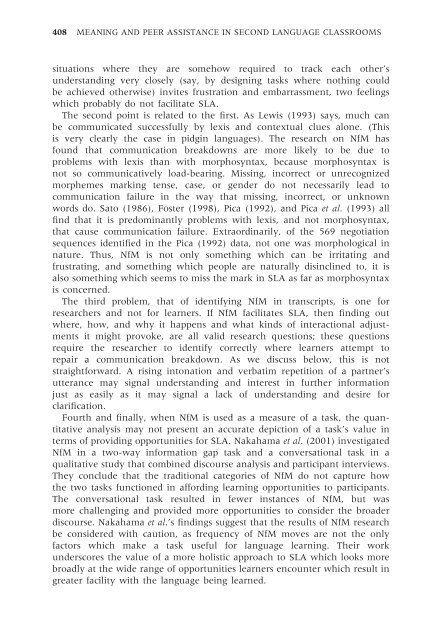Negotiation for Meaning and Peer Assistance in Second Language ...
Negotiation for Meaning and Peer Assistance in Second Language ...
Negotiation for Meaning and Peer Assistance in Second Language ...
Create successful ePaper yourself
Turn your PDF publications into a flip-book with our unique Google optimized e-Paper software.
408 MEANING AND PEER ASSISTANCE IN SECOND LANGUAGE CLASSROOMS<br />
situations where they are somehow required to track each other’s<br />
underst<strong>and</strong><strong>in</strong>g very closely (say, by design<strong>in</strong>g tasks where noth<strong>in</strong>g could<br />
be achieved otherwise) <strong>in</strong>vites frustration <strong>and</strong> embarrassment, two feel<strong>in</strong>gs<br />
which probably do not facilitate SLA.<br />
The second po<strong>in</strong>t is related to the first. As Lewis (1993) says, much can<br />
be communicated successfully by lexis <strong>and</strong> contextual clues alone. (This<br />
is very clearly the case <strong>in</strong> pidg<strong>in</strong> languages). The research on NfM has<br />
found that communication breakdowns are more likely to be due to<br />
problems with lexis than with morphosyntax, because morphosyntax is<br />
not so communicatively load-bear<strong>in</strong>g. Miss<strong>in</strong>g, <strong>in</strong>correct or unrecognized<br />
morphemes mark<strong>in</strong>g tense, case, or gender do not necessarily lead to<br />
communication failure <strong>in</strong> the way that miss<strong>in</strong>g, <strong>in</strong>correct, or unknown<br />
words do. Sato (1986), Foster (1998), Pica (1992), <strong>and</strong> Pica et al. (1993) all<br />
f<strong>in</strong>d that it is predom<strong>in</strong>antly problems with lexis, <strong>and</strong> not morphosyntax,<br />
that cause communication failure. Extraord<strong>in</strong>arily, of the 569 negotiation<br />
sequences identified <strong>in</strong> the Pica (1992) data, not one was morphological <strong>in</strong><br />
nature. Thus, NfM is not only someth<strong>in</strong>g which can be irritat<strong>in</strong>g <strong>and</strong><br />
frustrat<strong>in</strong>g, <strong>and</strong> someth<strong>in</strong>g which people are naturally dis<strong>in</strong>cl<strong>in</strong>ed to, it is<br />
also someth<strong>in</strong>g which seems to miss the mark <strong>in</strong> SLA as far as morphosyntax<br />
is concerned.<br />
The third problem, that of identify<strong>in</strong>g NfM <strong>in</strong> transcripts, is one <strong>for</strong><br />
researchers <strong>and</strong> not <strong>for</strong> learners. If NfM facilitates SLA, then f<strong>in</strong>d<strong>in</strong>g out<br />
where, how, <strong>and</strong> why it happens <strong>and</strong> what k<strong>in</strong>ds of <strong>in</strong>teractional adjustments<br />
it might provoke, are all valid research questions; these questions<br />
require the researcher to identify correctly where learners attempt to<br />
repair a communication breakdown. As we discuss below, this is not<br />
straight<strong>for</strong>ward. A ris<strong>in</strong>g <strong>in</strong>tonation <strong>and</strong> verbatim repetition of a partner’s<br />
utterance may signal underst<strong>and</strong><strong>in</strong>g <strong>and</strong> <strong>in</strong>terest <strong>in</strong> further <strong>in</strong><strong>for</strong>mation<br />
just as easily as it may signal a lack of underst<strong>and</strong><strong>in</strong>g <strong>and</strong> desire <strong>for</strong><br />
clarification.<br />
Fourth <strong>and</strong> f<strong>in</strong>ally, when NfM is used as a measure of a task, the quantitative<br />
analysis may not present an accurate depiction of a task’s value <strong>in</strong><br />
terms of provid<strong>in</strong>g opportunities <strong>for</strong> SLA. Nakahama et al. (2001) <strong>in</strong>vestigated<br />
NfM <strong>in</strong> a two-way <strong>in</strong><strong>for</strong>mation gap task <strong>and</strong> a conversational task <strong>in</strong> a<br />
qualitative study that comb<strong>in</strong>ed discourse analysis <strong>and</strong> participant <strong>in</strong>terviews.<br />
They conclude that the traditional categories of NfM do not capture how<br />
the two tasks functioned <strong>in</strong> af<strong>for</strong>d<strong>in</strong>g learn<strong>in</strong>g opportunities to participants.<br />
The conversational task resulted <strong>in</strong> fewer <strong>in</strong>stances of NfM, but was<br />
more challeng<strong>in</strong>g <strong>and</strong> provided more opportunities to consider the broader<br />
discourse. Nakahama et al.’s f<strong>in</strong>d<strong>in</strong>gs suggest that the results of NfM research<br />
be considered with caution, as frequency of NfM moves are not the only<br />
factors which make a task useful <strong>for</strong> language learn<strong>in</strong>g. Their work<br />
underscores the value of a more holistic approach to SLA which looks more<br />
broadly at the wide range of opportunities learners encounter which result <strong>in</strong><br />
greater facility with the language be<strong>in</strong>g learned.














